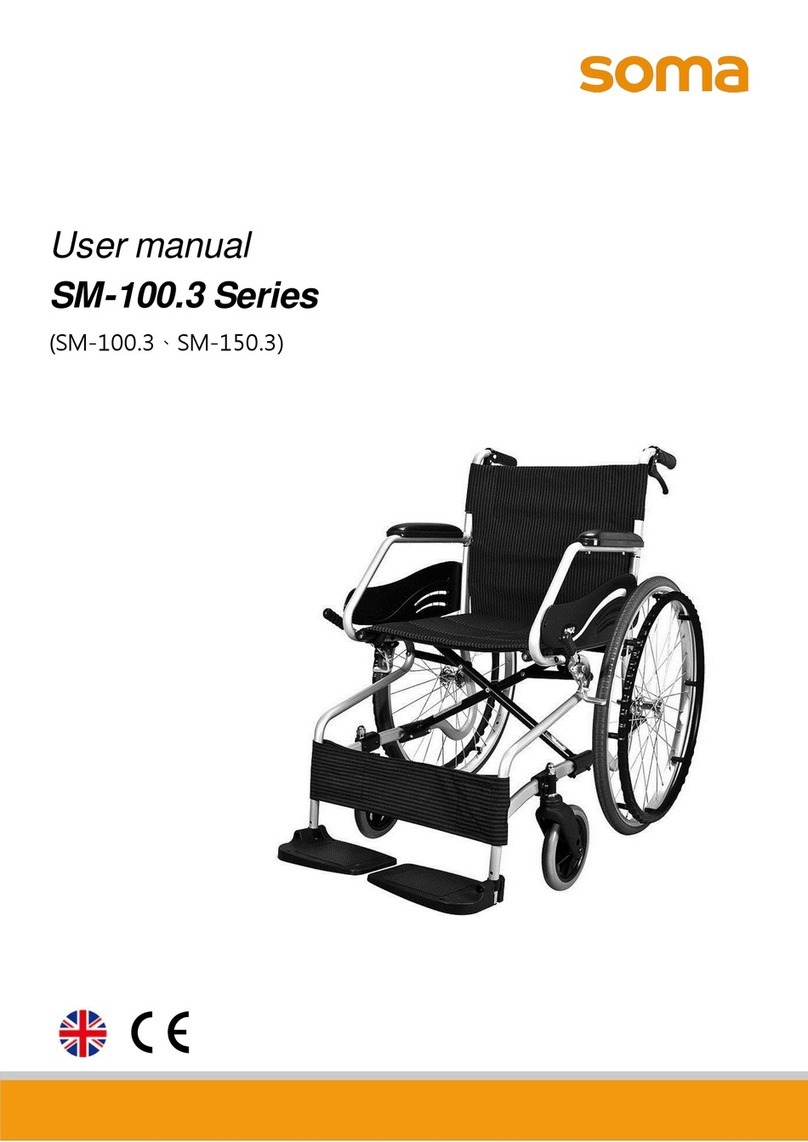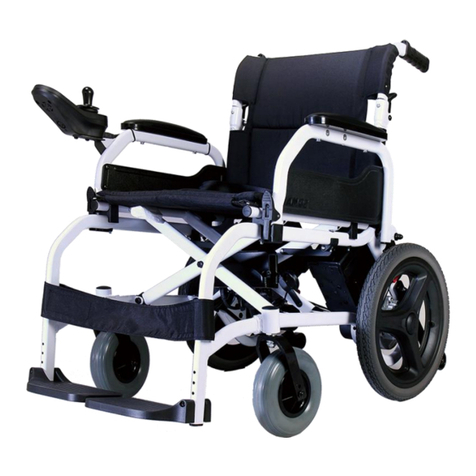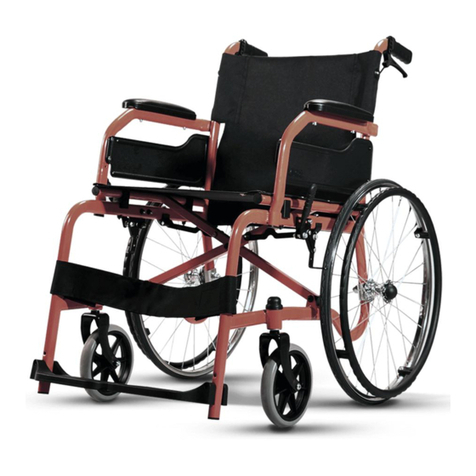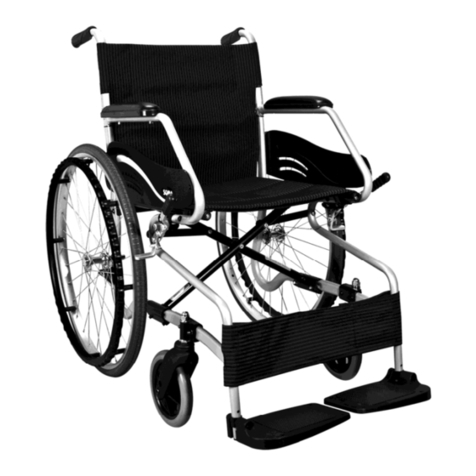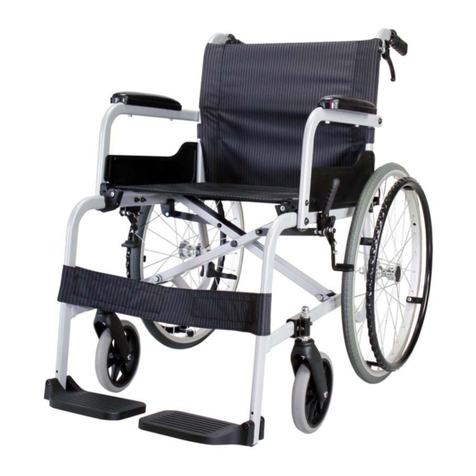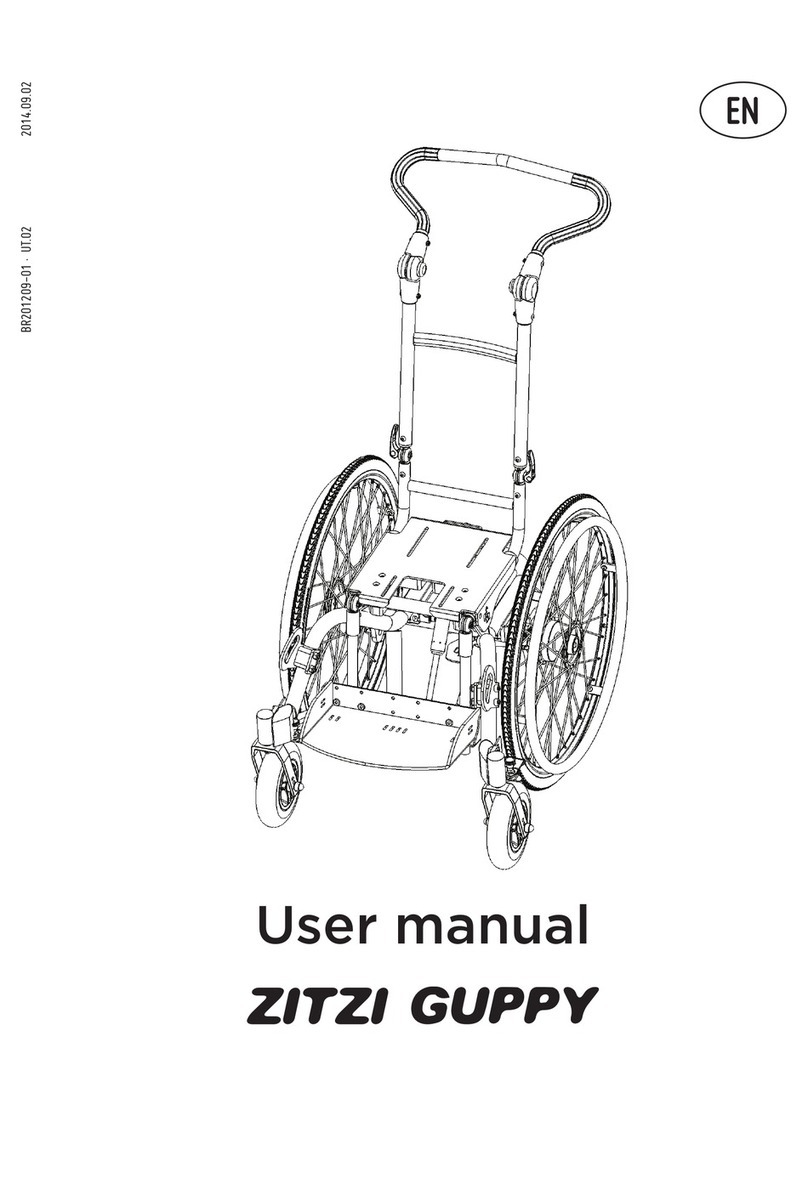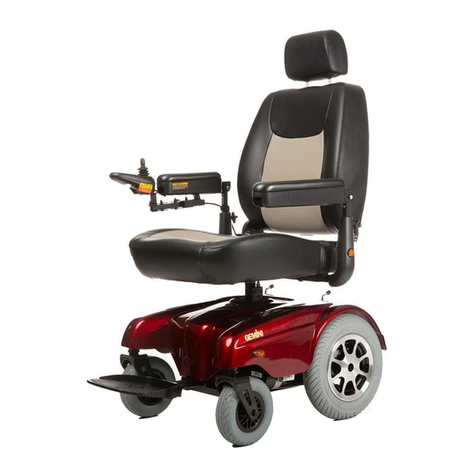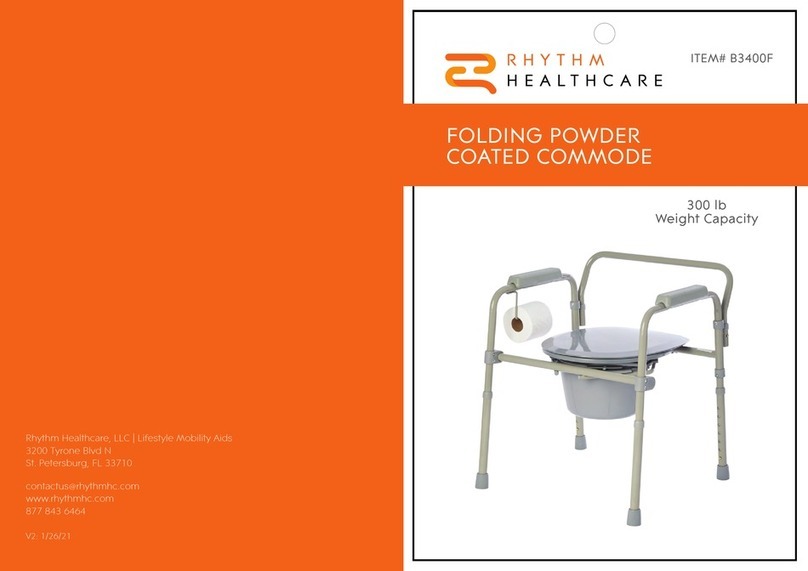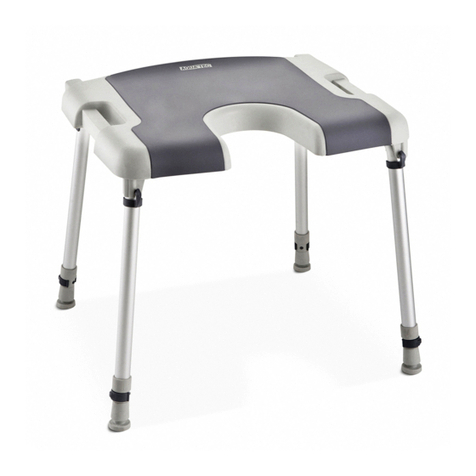SOMA 215 Series User manual

Manual Wheelchair Owner's Manual
SOMA 215 Series
(SM-250.5)

i
GENERAL WARNING
DO maintain your chair well, in particular check the tyre (tire) pressure since this affects
the efficiency of the brakes.
DO make sure both brakes are applied before getting in or out of the chair.
DO make sure both brakes are applied when the chair is not being pushed or used.
DO take care when climbing curbs or turning on slopes.
DO avoid steep or uneven surfaces that may cause the chair to tip over.
DO avoid soft surfaces because the casters may become bogged down.
DO travel smoothly in all conditions.
DO look well ahead to anticipate hazards such as furniture, doors, potholes, etc.
DO make sure that both feet are safely on the footrests and that clothing is safely tucked
out of the way so that it cannot get caught in the wheels.
DO take care when traveling up or down or across inclines.
DO keep both hands on the push handles to control the chair, if you are the attendant.
DO pay attention to keep the chair balanced.
DO check the frame and components regularly and refer to this user guide during and
after the warranty period.
DO tie-up the upholstery or replace it with a new one when it becomes loose.
DO lubricate bearings regularly.
DO equip with anti-tippers to avoid falling backwards.
DO equip with a seat belt designed for disabled people.
DO equip with "ankle supports" for disabled people.
DO clean both hands after oiling the wheelchair.
DO NOT overload the chair in any circumstance.
DO NOT hang anything heavy on the back of the chair that could cause the chair to
become unstable, particularly when negotiating inclines.
DO NOT allow more than one user at a time.
DO NOT allow any unconscious patient to use the wheelchair.
DO NOT use other transport to pull the wheelchair.
DO NOT do "wheelies", since you my fall or tip over backwards and suffer a severe
injury.
DO NOT sit in the wheelchair within a moving vehicle unless it has been affixed the
labels of hook mark.
DO NOT go too fast or turn too quickly.
DO NOT stand on the footplates when getting in or out of the chair.
DO NOT go down steps forward, whether solo or with an attendant.

ii
DO NOT attempt to lift the wheelchair by any removable (detachable) parts. Lifting by
means of any removable (detachable) parts of the wheelchair may result in injury to the
user and/or assistant or damage to the wheelchair.
DO NOT use the wheelchair when back joint folded to against tipping over backwards. It
is only for folding and storage purpose.
DO NOT hang anything on the back joint that could cause the backrest folding suddenly
and may cause injury.
YOU AND YOUR KARMA SERVICE PROVIDER
No tools are required for assembly. Your wheelchair should be assembled by your
authorized Karma dealer. Your authorized Karma dealer is also your service provider.
Unauthorized repairs, upgrades and add-ons will void your warranty. Anything
wheelchair related that requires tools should be done by your authorized Karma service
provider. Your Karma service provider has the necessary service/maintenance manual
for your wheelchair.
If you have any defective parts or lose any parts, please contact your dealer for repair
and/or replacement. Please only use parts authorized by Karma. Use of parts that are not
authorized by Karma will void your warranty.
Part numbers are listed on our bill of materials (explosion drawings), which we give to
our authorized dealers and service providers. Customers should order parts through their
dealer as well as all repairs and scheduled maintenance.
Customers should go to their dealership for all service needs to guarantee their warranty
is not void. Always go to an authorized service provider. Unauthorized repairs will void
your warranty. Procedures other than those described in this owner's manual must be
performed by a qualified technician. They also have the service manual with a complete
list of maintenance required to keep your Karma wheelchair in top performance. Check
the warranty section of this owner's manual to find out what Karma guarantees and what
maintenance service and parts that are not covered by the warranty.
Karma does not have an official list of service providers at this time. Please contact
your dealer for service. If you cannot contact your dealer, please contact another
authorized Karma dealer for service. If all else fails, contact Karma directly via our
website or give us a call and we can refer you to your new service provider.

iii
CE MARKING
This wheelchair complies with the requirements of the Medical Devices Directive
93/42/EEC.
CAUTION:
When prescribing wheelchairs for use by full or partial amputees (above or below knee,
single or double) or other conditions that affects the user's natural center of gravity and
might cause the wheelchair to tip or the person on the wheelchair to fall off, we suggest
contacting your therapist or dealer as well as attaching anti-tippers, pelvic belt, or other
additional safety accessories.
When using the wheelchair, ALWAYS follow the Highway Code or your local traffic
regulations when outdoors and the guidelines written in this manual.

TABLE OF CONTENTS
1. PREFACE ..................................................................................................................................... 1
2. SAFETY ........................................................................................................................................ 1
2.1 Doorways ....................................................................................................................1
2.2 Leaning ........................................................................................................................2
2.3 Negotiating Inclines ................................................................................................2
2.4 Kerb(Curbs) ................................................................................................................2
2.5 Stairs .............................................................................................................................3
2.6 Streets ..........................................................................................................................3
2.7 General ........................................................................................................................3
2.8 Upholstery ..................................................................................................................4
2.10 Maximum User Weight Limit .............................................................................4
2.11 Avoid General Misuse ..........................................................................................4
2.12 Labeling ....................................................................................................................5
3. INTENDED USE & PARTS .................................................................................................... 6
3.1 Intended Use .............................................................................................................6
3.2 Parts Description (SM-250.5 Series With 14"/20") .........................................7
4. OPERATION .............................................................................................................................. 7
4.1 Unfolding ....................................................................................................................7
4.2 Folding ........................................................................................................................8
4.3 Important DOs and DON'Ts .................................................................................9
4.4 Footplate Height ......................................................................................................9
4.5 How to Use the Tipping Lever ........................................................................... 10
4.6 Footrest Installation and Adjustment ............................................................. 10
4.7 Transporting and Storing ................................................................................... 10
4.8 Transferring In ........................................................................................................ 11
4.9 Transferring Out .................................................................................................... 12
4.10Attendant Pushing and Self-propelled ......................................................... 13
4.11 Tilting by the Attendant .................................................................................... 14
4.12 Tilting by the User ............................................................................................... 14
4.13 Going Down Curbs ............................................................................................. 15

4.14 Going Down Curbs Forwards With an Attendant ..................................... 15
4.15 Going Down Curbs Backwards With an Attendant .................................. 15
4.16 Going Up Curbs ................................................................................................... 16
4.17 Going Up Curbs Forwards With an Attendant ........................................... 16
4.18Going Up Curbs Backwards With an Attendant ......................................... 16
4.19Up and Down Steps/Stairs ................................................................................ 16
5. INSPECTION AND MAINTENANCE ............................................................................. 17
5.1 Daily Check.............................................................................................................. 17
5.2 Regular Maintenance Record ............................................................................ 17
6. OPTIONA AND ACCESSARIES ........................................................................................ 19
7. TROUBLESHOOTING .......................................................................................................... 20
8. SPECIFICATIONS .................................................................................................................. 21
9. CLEANING & RECYCLING ................................................................................................ 22
9.1 Cleaning ................................................................................................................... 22
9.2 Frame ........................................................................................................................ 22
9.3 Upholstery ............................................................................................................... 22
9.4 Post-Consumer Recycling .................................................................................. 22
10. WARRANTY .......................................................................................................................... 23
10.1 Serial Number ...................................................................................................... 23
10.2 Contents and Duration of Warranty ............................................................. 23
10.3 Items Not Covered by Warranty .................................................................... 23
10.4 Karma is Not Responsible for The Following Costs ................................. 24
10.5 The Responsibilities of the User ..................................................................... 24
10.6 The Responsibilities of the Dealer ................................................................. 24
10.7 Stipulations ........................................................................................................... 24
10.8 Warranty Duration and Parts Covered by the Warranty ........................ 24
10.9 Transfer of Warranty Rights ............................................................................. 24

1
1. PREFACE
Please carefully read this owner's manual before using the wheelchair. Improper use of
the wheelchair could result in harm or injury. Therefore, for safe and enjoyable use of
the wheelchair, please read this owner's manual.
1.1 This owner's manual includes operation instructions for the aspects of the
wheelchair, unfolding/folding instructions and instructions on how to deal
with possible accidents.
1.2 This owner's manual is written for Karma wheelchair: SM-250.5 series.
1.3 The symbols used in this owner's manual are explained below. Pay special
attention to the parts marked with these symbols.
WARNING: Improper use could lead the user to severe injury or death.
CAUTION: Improper use could lead the user to severe injury and/or damage
to your wheelchair.
SUGGESTION: Follow these instructions to keep the wheelchair in good
condition.
1.4 This owner's manual includes the repair and maintenance chart as well as
the warranty.
1.5 If someone else uses the wheelchair, make sure that you give him or her
this owner's manual for his or her reference.
1.6 As designs change, some illustrations and pictures in this owner's manual
may not correspond to the wheelchair that you purchased. We reserve
the right to make design modifications without further notice.
2. SAFETY
2.1 Doorways
The safest way to operate the chair is on level floors that are free of obstacles.
Whenever possible use a ramp to enter or exit a facility. Keeping your hands on the

2
push rims will allow you to maintain maximum balance. Do not try to force yourself
over an obstruction by propulsion and never use the sides of a doorway to pull
yourself through a passageway.
2.2 Leaning
Do not lean over the side of your wheelchair since such an action may cause you to
lose balance and fall. (See Figure 2.1)
Figure 2.1 Figure 2.2 Figure 2.3
2.3 Negotiating Inclines
2.3.1 Never turn on a hill due to the danger of tipping.
2.3.2 When assisting, go straight up a slope. If user needs to go down midway, walk
backwards until user is on level ground. (See Figures 2.2 and 2.3)
2.3.3 Avoid stopping on an incline; it can potentially cause you to lose control of the
chair.
2.3.4 Do not use the brakes to slow down or stop the wheelchair; this could cause it to
seize up, causing you to lose control or fall out of the chair.
2.3.5 Whenever possible, utilize help from an assistant/attendant while negotiating
inclines.
2.4 Kerb(Curbs)
2.4.1 Whenever possible get help from an assistant/attendant (if you have assistance
make sure that your chair is equipped with push handles).
2.4.2 Avoid hard impacts when descending a curb. A hard impact could adversely affect
the chair.
2.4.3 Never try to scale or descend curbs that exceed a normal height (30-50mm).
2.4.4 Always be careful when climbing curbs and never move up or down a curb in
reverse without an assistant.

3
2.5 Stairs
2.5.1 Always use two or more assistants. Tilt the wheelchair to its point of equilibrium.
One assistant (at the back) holds the wheelchair up against the first step, gripping
the handles firmly to lift. The second assistant, holding firmly a fixed part of the
front frame, lifts the wheelchair above the stairs and holds it while the first
attendant places one foot on the following step and repeat the operation. (See
Figure 2.4)
2.5.2 Never go down steps forwards.
2.5.3 Never use an escalator for transport, use an elevator.
Figure 2.4 Figure 2.5
2.6 Streets
2.6.1 Always use extreme caution when crossing streets. Reflective tape on the chair
and/or your clothing will make you more visible to drivers.
2.6.2 Avoid potholes and rough terrain that might cause the casters to become stuck.
(See Figure 2.5)
2.7 General
2.7.1 Always make sure BOTH brakes are applied before getting in or out of the chair.
2.7.2 Never stand on the footplates when getting in or out of the chair.
2.7.3 Never carry more than one passenger. Karma wheelchairs are limited to one user.
2.7.4 Use caution to assure your clothing doesn't get tangled with the wheels.
2.7.5 When the user is opearting the wheelchair using the pushrims, please push the
wheelchair gently. DO NOT apply a sudden huge force on the pushrims. It could
cause the chair to tip over. Please refer to the figure below for the best grip points
for using the pushrims.

4
2.8 Upholstery
2.8.1 When cleaning the upholstery, use warm water and a mild soap.
2.8.2 Upholstery cleaner/foam can also be used, but avoid other cleaning solvents.
Figure 2.7
2.10 Maximum User Weight Limit
Refer to "Max. User Weight" in Section 8. SPECIFICATIONS. Loads exceeding
maximum capacity can damage your wheelchair and cause malfunctions yielding a
safety hazard. The warranty does not cover damage caused by improper operation of
the wheelchair.
2.11 Avoid General Misuse
2.11.1 Please note that our "Owner's Manual" contains a number of cautions -- any
vehicle can cause injury if misused -- use within our guidelines and with
reasonable care and your safety will be increased. Your wheelchair will give years
of safe use if used sensibly and carefully. Be aware that careless use endangers
your own safety as well as that of others. ALWAYS follow the Highway Code
when outdoors and the guidelines written in this owner's manual.
2.11.2 Do not let children stand or play on the wheelchair. (See Figure 2.7)

5
2.12 Labeling
Please carefully read all the labeling on the wheelchair before driving it. Do not remove
them. Protect them for future reference.

6
3. INTENDED USE & PARTS
3.1 Intended Use
3.1.1 The SM-250 .5Series is a self-propelled or transit wheelchair. That is, it can either
be propelled by an attendant (transit) or by the user (self-propelled).
3.1.2 These wheelchairs are suitable for users up to 100 kg in weight. Hand brakes are
provided for both rear wheels.
3.1.3 The casters have PVC tyres (tires) for greater durability.
3.1.4 Rear wheels are 20 inches in diameter and solid PU tyres (tires).
3.1.5 SM-250.5 series are equipped with 14″ rear wheels.

7
3.2 Parts Description (SM-250.5 Series With 14"/20")
1. Push Handle
2. Attendant Brake
3. Parking Brake
4. Rear Wheel
5. Cross Frame(Cross Bar)
6. Caster
7. Backrest Upholstery
8. Armrest
9. Side Panel
10. Seat Upholstery
11. Tipping Lever
12. Footrest
13. Heel Loop
14. Footplate
4. OPERATION
4.1 Unfolding
4.1.1 Unfold the push handle. (See Figure 4.1)
4.1.2 Holding the armrests, pull outwards. (See Figure 4.2)

8
4.1.3 Pointing your fingers inward with the palm of your hand on the frame, push down
until the seat is fully lowered. Make sure the frame is firmly seated in its holder.
(See Figure 4.3)
4.1.4 Lift the footrests upward, swing them towards the middle and push them down
until they are fully locked. (See Figure 4.3.1、Figure 4.3.2)
4.1.5 Swing the footplates down. (See Figure 4.3.3)
4.1.6 Ready for action!
Alternatively, you can stand at the side of the chair and complete step 1 by pulling the
nearest armrest towards you and pushing the other one away.
Figure 4.1 Figure 4.2 Figure 4.3 Figure 4.3.1
Figure 4.3.2 Figure 4.3.3
CAUTION:
● When completing step 2, never put your fingers around the
sides or under the chair as they can be trapped between the
seat and the frame. (See Figure 4.5)
Figure 4.5
4.2 Folding
4.2.1 Flip up the footplates. (See Figure 4.6)
4.2.2 Lift the footrests upward, swing them outward to the side and push them down
until they are fully locked. (See Figure 4.6.1、Figure 4.6.2)
4.2.3 Pull up on the seat upholstery by holding it in the center of its front and back edge.
(See Figure 4.7)

9
4.2.4 Press the two release levers on the backrest frame (push handle tubes) to fold the
backrest down for compact storage and easy transport. (See Figure 4.8)
4.2.5 Folding is now completed.
Figure 4.6 Figure 4.6.1 Figure 4.6.2
Figure 4.7 Figure 4.8
CAUTION:
● Be careful not to get your fingers caught when folding the wheelchair.
4.3 Important DOs and DON'Ts
4.3.1 DO: Keep axles clean and lubricated with light oil or maintenance spray.
4.3.2 DO: Maintain correct tyre (tire) pressure if using pneumatic tyres (tires).
4.3.3 DO NOT: Try to remove the wheels while the wheelchair is occupied even when
using anti-tippers.
4.4 Footplate Height
4.4.1 To adjust footplate height use the Karma tool provided to loosen the bolt at the
bottom of the footrest arm.
4.4.2 Adjust to required height and re-tighten. (See Figure 4.11)

10
Figure 4.11 Figure 4.12
SUGGESTION:
●Make sure that the footplate height is adjusted properly according to the user's calf
length to reduce pressure on the body.
●The footrest height must be more than 5cm. (See Figure 4.12)
4.5 How to Use the Tipping Lever
4.5.1 Unfold the tipping lever with foot slightly. (See Figure 4.13).
4.5.2 Step the tipping lever downward with foot and hold the both push handles and
push them downward by two hands simultaneously to lift the caster to overcome
the obstacle. (See Figure 4.14).
4.5.3 The tipping lever can be folded with foot if you do not use it. (See Figure 4.15).
Figure 4.13 Figure 4.14 Figure 4.15 Figure 4.16
4.6 Footrest Installation and Adjustment
Install footrest:
4.6.1 Loose screws by using 5mm Allen key which bundled in the tool box and adjust
the length to an appropriate position to fit user’s leg-length. (Figure 4-16).
4.7 Transporting and Storing
Make sure the wheelchair is folded when it is stored.

11
SUGGESTION:
● Please store the wheelchair in a location where it is out of direct sunlight, rain, and
dew. For more details, consult your Karma dealer.
WARNING:
● Do not put anything on the wheelchair while it is in
storage. Storing goods on a folded wheelchair will cause
damage and is not covered by warranty. (See picture right.)
WARNING:
● The wheelchair cannot be used as seats in any vehicles. That is, KARMA
recommends that users are NOT transported in any vehicle while seated in the
wheelchair. In the case of accident or a sudden stop, the user could be thrown from
the wheelchair and get injured. The suggested solution is to transfer the user from
the wheelchair into a normal seat of the vehicle and to securely stow the
wheelchair in a separate c ompartment.
4.8 Transferring In
4.8.1 Engage both hand brakes.
4.8.2 Swing the footplates up.
4.8.3 The user lowers himself/ herself into the seat using the armrests for support.
4.8.4 Turn the footplates back down, so that the user can place his feet on them.
Ensure that the heels rest against the heel supports to prevent contact with the
casters.
4.8.5 Release both hand brakes.
CAUTION:
● Always ensure that the front casters are in line with the rear wheels and pointing
forwards and that the back of the chair is secure either against a wall or firmly held
by an attendant.

12
4.9 Transferring Out
4.9.1 Make sure that the chair is near the place you are transferring to.
4.9.2 Back the chair sufficiently to ensure that the casters are pointing forward, i.e. in line
with the rear wheels and usually with the caster forks pointing forward. Ensure
that, where possible, the rear of the chair is against a wall or, if not, it must be
firmly held by an attendant.
4.9.3 Engage both hand brakes.
4.9.4 Turn the footplates up and swing them to the side.
4.9.5 Slide forwards on the seat.
4.9.6 Place one foot firmly on the ground with the knee at a right angle and the other
foot slightly apart and further back.
4.9.7 Place your hands on the front of the armrests and moving your weight forward,
bring your head and shoulders up over your knees as you push yourself up.
CAUTION:
● Never stand on the footplates when getting into (or out of) the chair. (See
Figure 4.13)
● When getting in and out of the wheelchair please use the hand brakes. The hand
brake is the lever at the side of the wheelchair.
● Please ensure that neither the tread on your tires nor the brake block has
become too worn. If pneumatic tires are fitted, please maintain at the
recommended tire pressure for the same reason.
● Please ensure that occupant's fingers do not get caught in the brake.
● Do not lean on the side panel when transferring in or out.
Figure 4.13 Figure 4.14

13
When transferring in and out of the chair, make sure that the brakes are applied to
prevent the chair from sliding away. Also see that the footplates are flipped up for
ease of entering or exiting. (See Figure 4.14)
4.10Attendant Pushing and Self-propelled
4.10.1 Ensure that the brakes are always locked when the chair is not being pushed. (See
Figure 4.15)
4.10.2 Always make sure that both feet are safely on the footplates and that clothing is
safely tucked out of the way and cannot get caught in the wheels. (See Figure
4.16)
4.10.3 Always use both hands on the push handles to control the chair. (See Figure 4.17)
Figure 4.15 Figure 4.16 Figure 4.17
4.10.4 Always avoid steep or uneven surfaces because the chair may tip over. (See
Figure 4.18)
4.10.5 Always avoid soft surfaces because the casters may get bogged down. (See
Figure 4.19)
4.10.6 Always be careful not to go too fast or turn too quickly and try to achieve a
smooth steady ride.
4.10.7 Before crossing the tracks, please stop completely and look both ways.
4.10.8 Cross the tracks perpendicular to avoid your wheels getting stuck.
4.10.9 Do not drive at full speed over the railroad tracks.
4.10.10 Be careful going through a doorway that your hands and arms do not get
injured.
4.10.11 PLEASE keep in contact with the person in the chair. If you stop to look in shop
windows or talk to people, remember to turn the chair so that the person in the
chair does not have to turn.

14
WARNING:
● Never lock the brakes too suddenly as this may tip the user out of the chair.
Figure 4.18 Figure 4.19 Figure 4.20
4.11 Tilting by the Attendant
4.11.1 Make sure both the user's feet are on the footplates and will not slip off. Make
sure the handgrips are secure and cannot slip off.
4.11.2 Release both brakes.
4.11.3 Grasp both push handles firmly.
4.11.4 Put your stronger foot on the relevant tipping lever at the back of the chair.
4.11.5 Tell the person in the chair that you are about to tilt the chair backwards.
4.11.6 Pull back with both hands and push down and forwards with the foot. This will
bring the chair onto the back wheels. (See Figure 4.20)
CAUTION:
● When a chair is tilted to about 25 degrees it will balance on it's rear wheels and be
easy to hold. If it is tilted further back it will be difficult to hold and the person in
the chair will feel unsafe.
● Lower with a straight back; keep your foot on the anti-tipper and lower the chair
slowly forwards softly to the ground.
4.12 Tilting by the User
4.12.1 Make sure your feet are on the footplates and will not slip off.
4.12.2 Release both brakes.
4.12.3 Grasp both push rims and give a firm, sudden forward push immediately before
the obstacle, continue the momentum (be ready to keep pushing) until the
obstacle is mounted.
This manual suits for next models
3
Table of contents
Other SOMA Wheelchair manuals

